light Alfa Romeo 8C 2007 Owner handbook (in English)
[x] Cancel search | Manufacturer: ALFA ROMEO, Model Year: 2007, Model line: 8C, Model: Alfa Romeo 8C 2007Pages: 223, PDF Size: 14.35 MB
Page 198 of 223
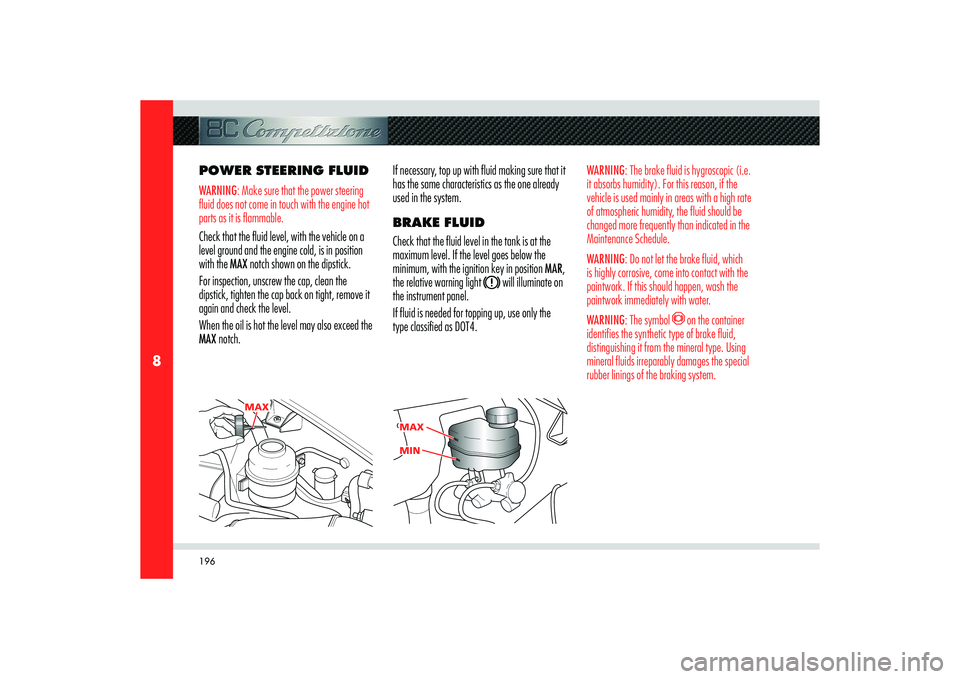
196
8
MAX
MA
X MAX
MIN MIN
POWER STEERING FLUIDWARNING: Make sure that the power steering
fluid does not come in touch with the engine hot
parts as it is flammable.Check that the fluid level, with the vehicle on a
level ground and the engine cold, is in position
with the MAX notch shown on the dipstick.
For inspection, unscrew the cap, clean the
dipstick, tighten the cap back on tight, remove it
again and check the level.
When the oil is hot the level may also exceed the
MAX notch.If necessary, top up with fluid making sure that it
has the same characteristics as the one already
used in the system.
BRAKE FLUID
Check that the fluid level in the tank is at the
maximum level. If the level goes below the
minimum, with the ignition key in position MAR,
the relative warning light
will illuminate on
the instrument panel.
If fluid is needed for topping up, use only the
type classified as DOT4.
WARNING: The brake fluid is hygroscopic (i.e.
it absorbs humidity). For this reason, if the
vehicle is used mainly in areas with a high rate
of atmospheric humidity, the fluid should be
changed more frequently than indicated in the
Maintenance Schedule.
WARNING: Do not let the brake fluid, which
is highly corrosive, come into contact with the
paintwork. If this should happen, wash the
paintwork immediately with water.
WARNING: The symbol
on the container
identifies the synthetic type of brake fluid,
distinguishing it from the mineral type. Using
mineral fluids irreparably damages the special
rubber linings of the braking system.
Page 200 of 223

198
8
A
B
C
BATTERYThe battery is of the “low maintenance” type,
and is located on the right side of the luggage
compartment
To access the battery lift the shelf and
A and the
box cover
B releasing the hooks.
C.
With the vehicle standing on a flat surface, the
battery fluid level (electrolyte) must be between
the MIN and MAX reference notches shown on
the battery.
If the level is lower than the MIN reference
notch, contact an Authorised Service Centre
of the Manufacturer’s Network to have it
checked.To recharge the battery, see the section “In an
emergency”.
CAUTION
The fluid contained in the
battery is poisonous and corrosive.
Avoid contact with the skin and eyes.
Do not approach the battery with open
flames or possible sources of sparks:
risk of explosion and fire!
Batteries contain substances that are very
harmful for the environment. We advise you
to have the battery replaced at an Authorised
Service Centre of the Manufacturer’s
Network, where all the necessary equipment
is available to dispose of the used parts in compliance with applicable legislation and in an
environment-friendly manner.
WARNING: Incorrect assembly of electrical and
electronic accessories can cause serious damage
to the vehicle.USEFUL HINTS FOR
EXTENDING THE LIFE OF
THE BATTERY
When parking the vehicle, make sure that the
doors, luggage and engine compartment lids
are properly closed. All interior lights should be
off. When the engine is off, do not keep the
connected devices switched on for a long time
(for example the radio, the hazard warning
lights, the fan, etc.).
Page 207 of 223

205
8
MAINTENANCE
Normal paint maintenance consists in washing,
the frequency of which depends on the
conditions of use and of the environment.
For example, in areas where there is high
atmospheric pollution or if the roads are spread
with anti-freeze salt, it is advisable to wash the
vehicle more frequently. WARNING: Detergents pollute water. Therefore
the vehicle should be washed in areas equipped
for the collection and purification of the fluids
used for washing.For correct washing:
- Wet the bodywork with a low-pressure
water jet.
- Run a sponge soaked in a neutral detergent
solution over the bodywork, remembering
to rinse the sponge frequently.
- Thoroughly rinse with water and dry with a
jet of air or suede.
When drying, take particular care with the parts
that are less visible, such as the door bays, front
lid, headlight edges, in which water can be
trapped more easily. You are recommended not to take the vehicle
immediately into an enclosed environment, but
leave it in the open air so as to allow the water
to evaporate.
Do not wash the vehicle after it has been left in
the sun or when the hood is hot: the paint gloss
could be affected.
External plastic parts must be cleaned with the
same procedure followed for the normal washing
of the vehicle.
Avoid, as far as possible, parking the vehicle
under trees; the resinous substances that very
often drop from the trees give the paint a dull
appearance and increase the possibility of
originating corrosive processes.
WARNING: Bird droppings must be washed off
immediately and thoroughly, since their acidity is
particularly corrosive.
WARNING: To provide better protection for the
paint, polish the vehicle at regular intervals with
a suitable product leaving a protective film on
the paint.
Windows
To clean the windows use special detergents.
Only use clean cloths so as not to scratch the
windows or rendering them less transparent. WARNING: In order not to damage the electric
elements fitted inside the heated rear window,
rub gently following the direction of the
elements. ENGINE COMPARTMENT
At the end of each winter season, carefully wash
the engine compartment, remembering to not
direct the jet of water for too long on the ECUs
and on the relay and fuse boxes on the right-
hand side of the engine compartment (driving
direction). To perform this operation, you must
contact a specialised workshop. WARNING: Wash only when the engine is cold
and with the ignition key turned to STOP. After
washing, make sure that the various protections
(e.g. rubber boots/caps, guards etc.) have not
been removed or damaged.
Page 208 of 223

206
8
INTERIORSCheck at regular intervals that there is no water
trapped under the mats (due to drips off shoes,
umbrellas etc.) which may cause the metal parts
to oxidise.
CLEANING THE LEATHER
UPHOLSTERY
- Remove the dried dirt with a slightly damp
deerskin or a cloth, without rubbing too
hard.
- Remove any liquid or grease stains with a
dry absorbent cloth, without rubbing.
- Then run a soft cloth or deerskin damped
with water and neutral detergent.
- If the stain persists, use specifi c products
carefully following the instructions for use. WARNING: Never use alcohol, alcohol-based
products or solvents.
It is in any case advisable to use the Car Care
Kit (specifically for cleaning leather) included in
the Alfa Romeo accessory line. The kit cannot be
used on suede.
LEATHER UPHOLSTERY
TREATMENT
Have the leather upholstery treated according
to the Maintenance Schedule and only
at an Authorised Service Centre of the
Manufacturer’s Network, where the specific
products required for the treatment are available.CARBON PARTS
Have small scratches and marks on the carbon
structure removed by an Authorised Service
Centre of the Manufacturer’s Network.
Improper operations may irreparably damage the
carbon parts.
CAUTION
Do not use aggressive organic
substances, such as: petrol, kerosene,
petroleum, acetone or solvents.
Page 211 of 223

209
8
MAINTENANCE
Always first disconnect the power cable from
the mains and then disconnect the battery
conditioner from the vehicle socket. WARNING: The vehicle cannot be started as
long as the battery conditioner is connected to
the vehicle socket (even when it is disconnected
from the mains).When the warning light (1) is on permanently: it
means that there is an electric system fault in the
vehicle or the battery.
When the warning light (2) is on permanently:
it means that the battery conditioner is in the
“Active” phase. During this phase the battery
is recharged to the optimal charge level, from a
lower one.
When the warning light (3) is on permanently:
it means that the battery is fully charged and the
battery conditioner is in the “Passive” phase.
During this phase, the device maintains the
battery at an optimal charge level.
When the warning lights (2 and 3) are on and
flash alternately:
- if the warning lights fl ash a few times a
second, it means that the battery may be
sulphated. - if the warning lights fl ash alternately for
more than 60 minutes, it means that the
battery must be replaced.
- if the warning lights fl ash at intervals of a
few minutes, it means that the battery self-
discharge percentage is high and it might
have to be replaced.
When no warning light is on, the following may
have occurred:
- the battery conditioner cables may be
disconnected;
- the battery may not be properly connected
to the vehicle system;
- the battery may be defective;- the battery voltage may be low or there
may be a lack of power on the mains
socket.
1- error warning light
2- active phase warning light: signalling
3- maintenance warning light: maintenance
After checking the connection of the battery
conditioner (both to the mains and the vehicle
socket) and that the mains are powered, if
the (2 or 3) “Active” and “Passive” phase
warning lights do not illuminate a few seconds
after connecting the battery conditioner,
contact an Authorised Service Centre of the
Manufacturer’s Network to have the electric
system of the vehicle checked.
1
2
3
Page 218 of 223
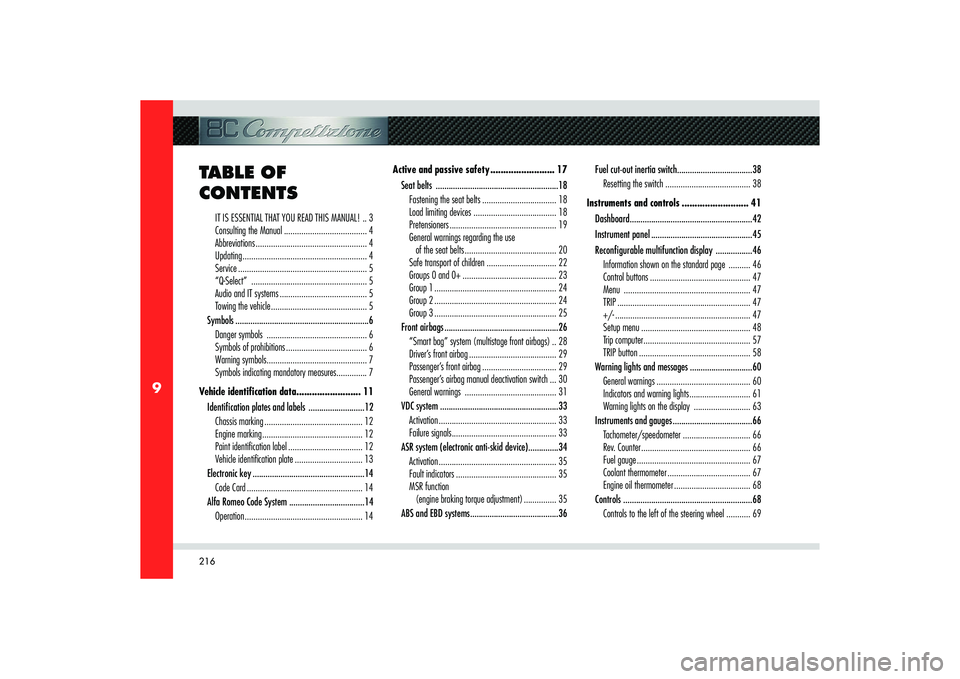
216
9
IT IS ESSENTIAL THAT YOU READ THIS MANUAL! .. 3
Consulting the Manual ...................................... 4
Abbreviations ................................................... 4
Updating ......................................................... 4
Service ........................................................... 5
“Q-Select” ..................................................... 5
Audio and IT systems ........................................ 5
Towing the vehicle ............................................ 5
Symbols ..............................................................6
Danger symbols .............................................. 6
Symbols of prohibitions ..................................... 6
Warning symbols .............................................. 7
Symbols indicating mandatory measures .............. 7
Vehicle identifi cation data ......................... 11
Identi� cation plates and labels ..........................12
Chassis marking ............................................. 12
Engine marking .............................................. 12
Paint identifi cation label .................................. 12
Vehicle identifi cation plate ............................... 13
Electronic key ....................................................14
Code Card ..................................................... 14
Alfa Romeo Code System ...................................14
Operation ...................................................... 14Active and passive safety ......................... 17
Seat belts .........................................................18
Fastening the seat belts .................................. 18
Load limiting devices ...................................... 18
Pretensioners ................................................. 19
General warnings regarding the use
of the seat belts .......................................... 20
Safe transport of children ................................ 22
Groups 0 and 0+ ........................................... 23
Group 1 ........................................................ 24
Group 2 ........................................................ 24
Group 3 ........................................................ 25
Front airbags .....................................................26
“Smart bag” system (multistage front airbags) .. 28
Driver’s front airbag ........................................ 29
Passenger’s front airbag .................................. 29
Passenger’s airbag manual deactivation switch ... 30
General warnings .......................................... 31
VDC system .......................................................33
Activation ...................................................... 33
Failure signals ................................................ 33
ASR system (electronic anti-skid device) ..............34
Activation ...................................................... 35
Fault indicators .............................................. 35
MSR function
(engine braking torque adjustment) ............... 35
ABS and EBD systems .........................................36Fuel cut-out inertia switch ...................................38
Resetting the switch ....................................... 38
Instruments and controls .......................... 41
Dashboard .........................................................42
Instrument panel ...............................................45
Recon� gurable multifunction display .................46
Information shown on the standard page .......... 46
Control buttons .............................................. 47
Menu .......................................................... 47
TRIP ............................................................. 47
+/- .............................................................. 47
Setup menu .................................................. 48
Trip computer ................................................. 57
TRIP button ................................................... 58
Warning lights and messages .............................60
General warnings ........................................... 60
Indicators and warning lights ............................ 61
Warning lights on the display .......................... 63
Instruments and gauges .....................................66
Tachometer/speedometer ............................... 66
Rev. Counter .................................................. 66
Fuel gauge .................................................... 67
Coolant thermometer ...................................... 67
Engine oil thermometer ................................... 68
Controls ............................................................68
Controls to the left of the steering wheel ........... 69
TABLE OF
CONTENTS
Page 219 of 223
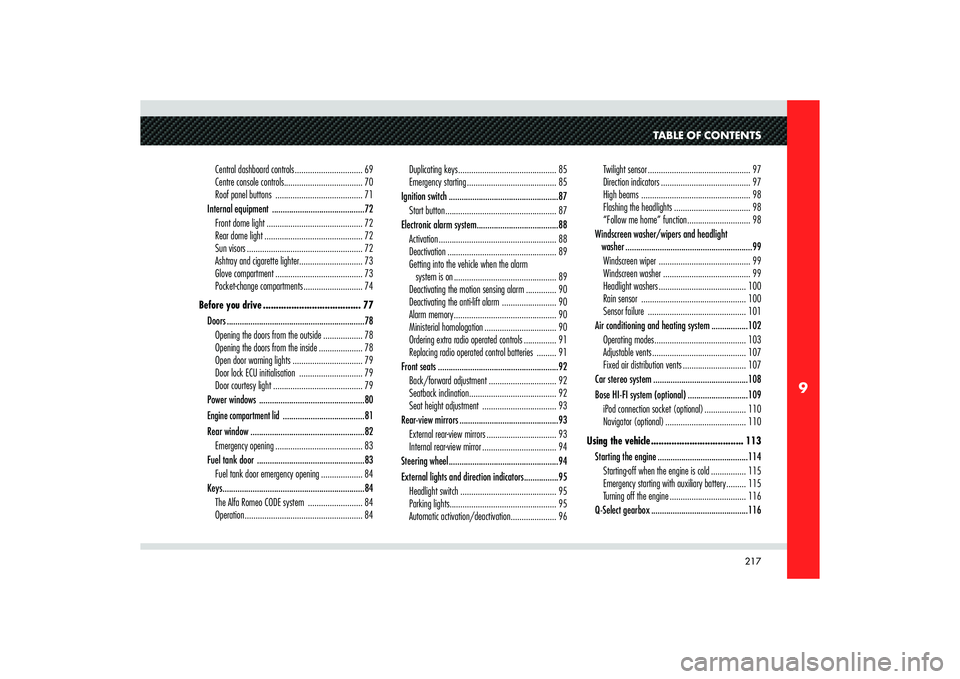
217
9
TABLE OF CONTENTS
Central dashboard controls ............................... 69
Centre console controls .................................... 70
Roof panel buttons ........................................ 71
Internal equipment ...........................................72
Front dome light ............................................ 72
Rear dome light ............................................. 72
Sun visors ..................................................... 72
Ashtray and cigarette lighter ............................. 73
Glove compartment ........................................ 73
Pocket-change compartments ........................... 74
Before you drive ...................................... 77
Doors ................................................................78
Opening the doors from the outside .................. 78
Opening the doors from the inside .................... 78
Open door warning lights ................................ 79
Door lock ECU initialisation ............................. 79
Door courtesy light ......................................... 79
Power windows .................................................80Engine compartment lid
......................................81
Rear window .....................................................82
Emergency opening ........................................ 83
Fuel tank door ..................................................83
Fuel tank door emergency opening ................... 84
Keys ..................................................................84
The Alfa Romeo CODE system ......................... 84
Operation ...................................................... 84Duplicating keys ............................................. 85
Emergency starting ......................................... 85
Ignition switch ...................................................87
Start button ................................................... 87
Electronic alarm system ......................................88
Activation ...................................................... 88
Deactivation .................................................. 89
Getting into the vehicle when the alarm
system is on ............................................... 89
Deactivating the motion sensing alarm .............. 90
Deactivating the anti-lift alarm ......................... 90
Alarm memory ............................................... 90
Ministerial homologation ................................. 90
Ordering extra radio operated controls ............... 91
Replacing radio operated control batteries ......... 91
Front seats ........................................................92
Back/forward adjustment ............................... 92
Seatback inclination ........................................ 92
Seat height adjustment .................................. 93
Rear-view mirrors ..............................................93
External rear-view mirrors ................................ 93
Internal rear-view mirror .................................. 94
Steering wheel ...................................................94
External lights and direction indicators ................95
Headlight switch ............................................ 95
Parking lights ................................................. 95
Automatic activation/deactivation ..................... 96Twilight sensor ............................................... 97
Direction indicators ......................................... 97
High beams .................................................. 98
Flashing the headlights ................................... 98
“Follow me home” function ............................. 98
Windscreen washer/wipers and headlight
washer ...........................................................99
Windscreen wiper .......................................... 99
Windscreen washer ........................................ 99
Headlight washers ........................................ 100
Rain sensor ................................................ 100
Sensor failure ............................................. 101
Air conditioning and heating system .................102
Operating modes .......................................... 103
Adjustable vents ........................................... 107
Fixed air distribution vents ............................. 107
Car stereo system ............................................108
Bose HI-FI system (optional) ............................109
iPod connection socket (optional) ................... 110
Navigator (optional) ..................................... 110
Using the vehicle .................................... 113
Starting the engine ..........................................114
Starting-off when the engine is cold ................ 115
Emergency starting with auxiliary battery ......... 115
Turning off the engine ................................... 116
Q-Select gearbox .............................................116
Page 220 of 223
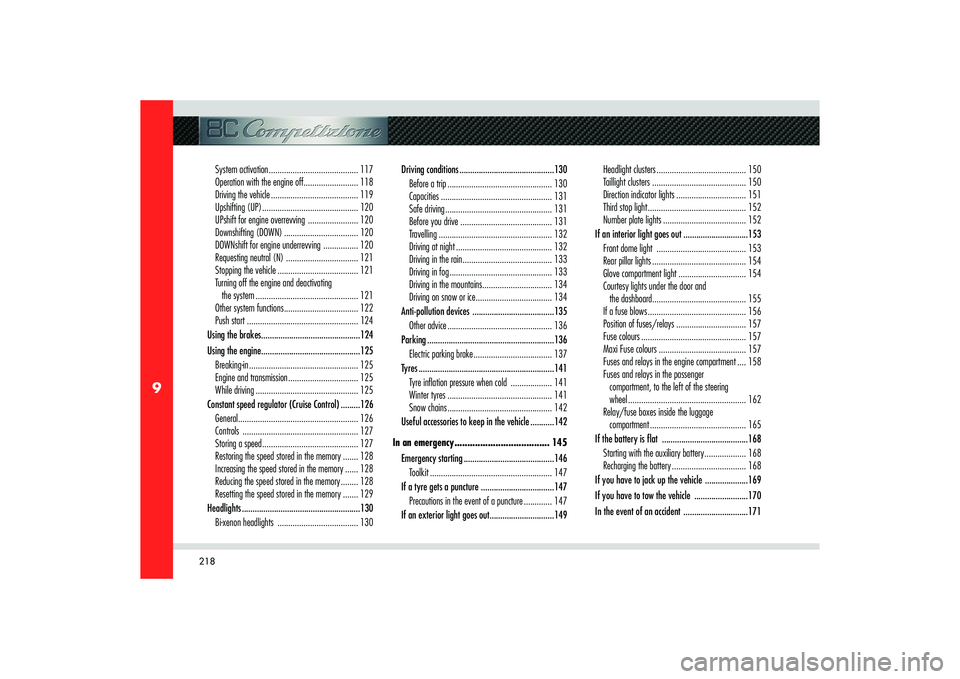
218
9
System activation ......................................... 117
Operation with the engine off ......................... 118
Driving the vehicle ........................................ 119
Upshifting (UP) ............................................ 120
UPshift for engine overrevving ....................... 120
Downshifting (DOWN) .................................. 120
DOWNshift for engine underrevving ................ 120
Requesting neutral (N) ................................. 121
Stopping the vehicle ..................................... 121
Turning off the engine and deactivating
the system ............................................... 121
Other system functions .................................. 122
Push start ................................................... 124
Using the brakes ..............................................124
Using the engine ..............................................125
Breaking-in .................................................. 125
Engine and transmission ................................ 125
While driving ............................................... 125
Constant speed regulator (Cruise Control) .........126
General ....................................................... 126
Controls ..................................................... 127
Storing a speed ............................................ 127
Restoring the speed stored in the memory ....... 128
Increasing the speed stored in the memory ...... 128
Reducing the speed stored in the memory ........ 128
Resetting the speed stored in the memory ....... 129
Headlights .......................................................130
Bi-xenon headlights ..................................... 130Driving conditions ............................................130
Before a trip ................................................ 130
Capacities ................................................... 131
Safe driving ................................................. 131
Before you drive .......................................... 131
Travelling .................................................... 132
Driving at night ............................................ 132
Driving in the rain ......................................... 133
Driving in fog ............................................... 133
Driving in the mountains ................................ 134
Driving on snow or ice ................................... 134
Anti-pollution devices ......................................135
Other advice ................................................ 136
Parking ...........................................................136
Electric parking brake .................................... 137
Tyres ...............................................................141
Tyre infl ation pressure when cold ................... 141
Winter tyres ................................................ 141
Snow chains ................................................ 142
Useful accessories to keep in the vehicle ...........142
In an emergency ..................................... 145
Emergency starting ..........................................146
Toolkit ........................................................ 147
If a tyre gets a puncture ..................................147
Precautions in the event of a puncture ............. 147
If an exterior light goes out ..............................149Headlight clusters ......................................... 150
Taillight clusters ........................................... 150
Direction indicator lights ................................ 151
Third stop light ............................................. 152
Number plate lights ...................................... 152
If an interior light goes out ..............................153
Front dome light ......................................... 153
Rear pillar lights ........................................... 154
Glove compartment light ............................... 154
Courtesy lights under the door and
the dashboard ........................................... 155
If a fuse blows ............................................. 156
Position of fuses/relays ................................ 157
Fuse colours ................................................ 157
Maxi Fuse colours ........................................ 157
Fuses and relays in the engine compartment .... 158
Fuses and relays in the passenger
compartment, to the left of the steering
wheel ...................................................... 162
Relay/fuse boxes inside the luggage
compartment ............................................ 165
If the battery is � at ........................................168
Starting with the auxiliary battery ................... 168
Recharging the battery .................................. 168
If you have to jack up the vehicle ....................169
If you have to tow the vehicle .........................170
In the event of an accident ..............................171
Page 221 of 223
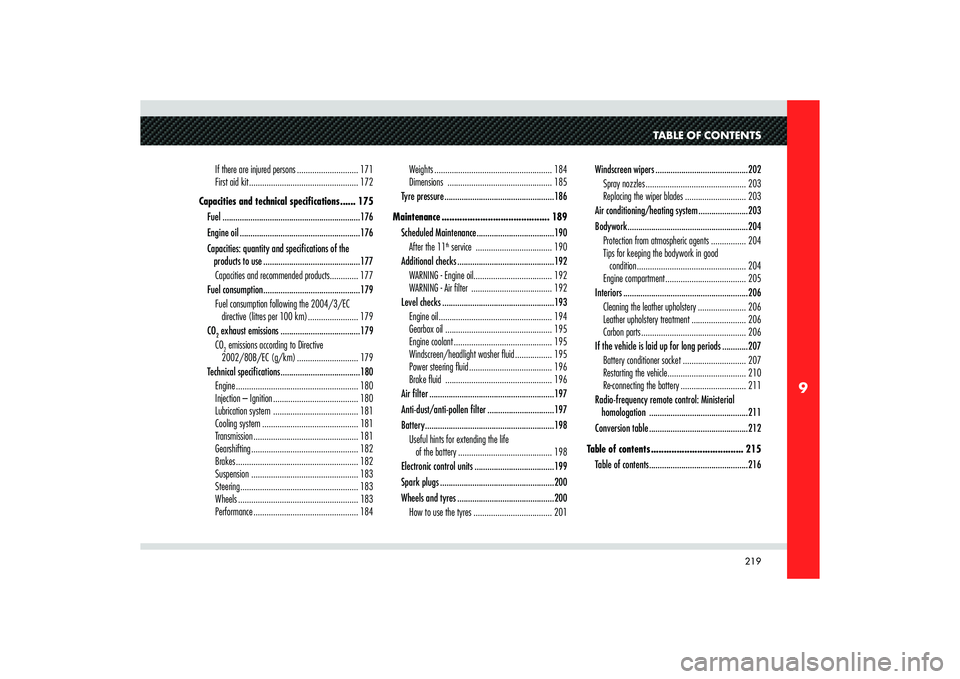
219
9
TABLE OF CONTENTS
If there are injured persons ............................ 171
First aid kit .................................................. 172
Capacities and technical specifi cations ...... 175
Fuel ................................................................176
Engine oil ........................................................176
Capacities: quantity and speci� cations of the
products to use .............................................177
Capacities and recommended products ............. 177
Fuel consumption .............................................179
Fuel consumption following the 2004/3/EC
directive (litres per 100 km) ....................... 179
CO2 exhaust emissions .....................................179
CO2 emissions according to Directive
2002/80B/EC (g/km) ............................ 179
Technical speci� cations .....................................180
Engine ........................................................ 180
Injection – Ignition ....................................... 180
Lubrication system ....................................... 181
Cooling system ............................................ 181
Transmission ................................................ 181
Gearshifting ................................................. 182
Brakes ........................................................ 182
Suspension ................................................. 183
Steering ...................................................... 183
Wheels ....................................................... 183
Performance ................................................ 184Weights ...................................................... 184
Dimensions ................................................ 185
Tyre pressure ...................................................186
Maintenance .......................................... 189
Scheduled Maintenance ....................................190
After the 11
th service ................................... 190
Additional checks .............................................192
WARNING - Engine oil .................................... 192
WARNING - Air fi lter ..................................... 192
Level checks ....................................................193
Engine oil .................................................... 194
Gearbox oil ................................................. 195
Engine coolant ............................................. 195
Windscreen/headlight washer fl uid ................. 195
Power steering fl uid ...................................... 196
Brake fl uid ................................................. 196
Air � lter ..........................................................197
Anti-dust/anti-pollen � lter ...............................197
Battery ............................................................198
Useful hints for extending the life
of the battery ........................................... 198
Electronic control units .....................................199
Spark plugs .....................................................200
Wheels and tyres .............................................200
How to use the tyres .................................... 201Windscreen wipers ...........................................202
Spray nozzles .............................................. 203
Replacing the wiper blades ............................ 203
Air conditioning/heating system .......................203
Bodywork ........................................................204
Protection from atmospheric agents ................ 204
Tips for keeping the bodywork in good
condition .................................................. 204
Engine compartment ..................................... 205
Interiors ..........................................................206
Cleaning the leather upholstery ...................... 206
Leather upholstery treatment ......................... 206
Carbon parts ................................................ 206
If the vehicle is laid up for long periods ............207
Battery conditioner socket ............................. 207
Restarting the vehicle .................................... 210
Re-connecting the battery .............................. 211
Radio-frequency remote control: Ministerial
homologation ..............................................211
Conversion table ..............................................212
Table of contents .................................... 215
Table of contents ..............................................216